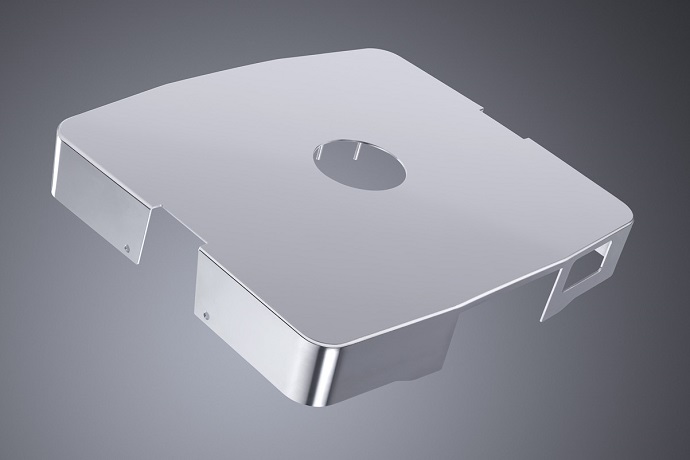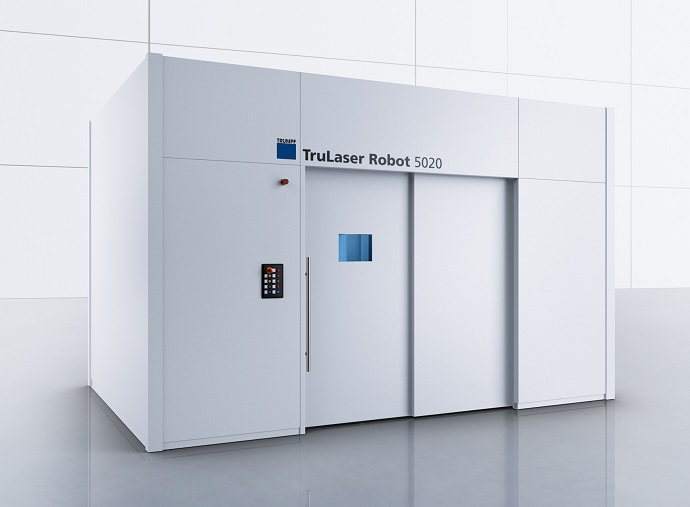Ditzingen, July 09, 2015 – The new TruLaser Robot 5020 Basic Edition, built by TRUMPF, is especially tailored to those making their debut in laser welding for sheet metal. It is less expensive than its big sister TruLaser Robot 5020 and it requires less floor space. In spite of this, it produces seams with excellent surface quality and high-strength, narrow and deep seams in every conceivable shape. The compact and affordable robot system has six axes and welds mild steel, stainless steel and aluminum at sheet thicknesses up to four millimeters in the best and highly reproducible quality. Parts measuring up to 1,200 x 800 x 600 millimeters can easily be worked. The rotate and tilt positioner makes for superb productivity and a high utilization rate. It permits complete 3D processing of the parts while ensuring good accessibility.
Economical laser welding
The TruLaser Robot 5020 Basic Edition is available in two reasonable models. Those who order the complete system, including the laser source, receive the machine with a TruDiode direct diode laser. With its 40 percent efficiency, users benefit not only from the reduced entry price for the system, but in addition from low operating costs. And the user also saves on floor space, since this solution requires far less space.
If the company already owns a punching and laser cutting machine or a 2D laser unit incorporating the TruDisk solid-state laser, then a second variation is possible. The laser can power an additional unit integrated into its laser network, for instance the TruLaser Robot 5020 Basic Edition. This reduces by up to 50 percent the investment costs when entering the field of laser welding and ensures ideal utilization of the beam source. The TruDisk switches in just milliseconds from the punch laser or the laser cutting machine to the robot welding cell. In this way set-up or tool changing times at the cutting unit can be utilized efficiently for laser welding.
Laser welding is better
Those to make this step and invest in the TruLaser Robot 5020 Basic Edition will be moving up to a fully new quality class in sheet metal processing. This starts with the superior seam quality. Heat conduction welding, in particular, produces seams with outstanding surface quality. This makes it possible to weld visible seams without any retouching work at all. And since less heat enters the part during laser welding, there is almost no distortion. This also eliminates the need for subsequent leveling of the sheet.

Laser welding
Laser welding, when compared with conventional techniques, offers numerous advantages such as superior seam quality, high strength in the welding seam, and minimum distortion.
Photo: TRUMPF
Another advantage of this technique is the high strength of the welded seam. Deep penetration welding scores here because this procedure generates narrow, deep, high-strength seams. In addition, they make for a better bond than conventional seams. In tension testing at materials inspection laboratories, the latter invariably come apart at or near the seam while the laser-welded seam holds tight. In fact, the specimens fail in the material being welded. This shows that the tensile strength of a laser-welded seam is not only higher than that of a conventionally welded seam. It is actually higher than the material being bonded.
In terms of flexibility and speed, as well, the laser is more than convincing. Especially during deep penetration welding, the laser reaches a speed of up to five meters per minute. In addition, it can handle every conceivable kind of joint and every geometry – even if the area being welded is accessible only from one side. Lap seams, a hidden T-joint, and even materials of differing thicknesses can be welded with the laser. This opens a wealth of new options for part design.












